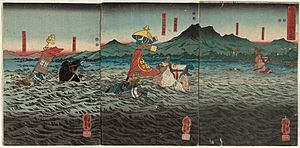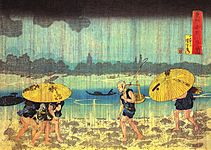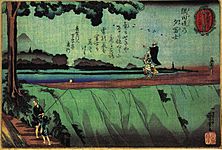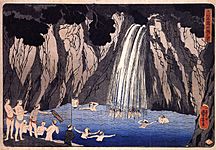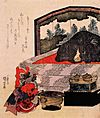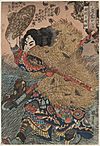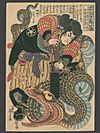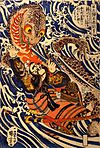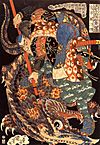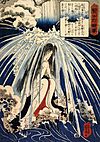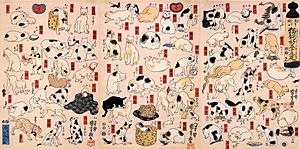Utagawa Kuniyoshi facts for kids
Quick facts for kids
Utagawa Kuniyoshi
|
|
|---|---|
| 歌川 国芳 | |

Self-portrait from the album Chinpen shinkeibai, 1839
|
|
| Born |
Utagawa Kuniyoshi
1 January 1798 |
| Died | 14 April 1861 (aged 63) |
| Nationality | Japanese |
| Education | Utagawa Toyokuni I, Katsukawa Shuntei, Tsutsumi Tori |
| Known for | Painter , printmaker, ukiyo-e artist, artist, illustrator |
|
Notable work
|
"Soma's Kouchi Ura" and others |
| Movement | Ukiyo-e |
Utagawa Kuniyoshi (Japanese: 歌川 国芳, born January 1, 1798 – died April 14, 1861) was a famous Japanese artist. He was one of the last great masters of the ukiyo-e style. Ukiyo-e means "pictures of the floating world." This art style uses woodblock prints and paintings. Kuniyoshi was part of the Utagawa school, a well-known art group.
Kuniyoshi created art about many different things. He drew beautiful landscapes and women. He also drew Kabuki actors, cats, and mythical animals. He was especially famous for showing battles of legendary samurai heroes. His art even used some ideas from Western art, like how light and shadows work. He also made funny pictures called caricatures.
Contents
The Early Life of Kuniyoshi
Kuniyoshi was born on January 1, 1798. His first name was Yoshisaburō. His father, Yanagiya Kichiyemon, was a silk-dyer. It seems Kuniyoshi helped his father design patterns. This might be why his prints have such rich colors and textile designs.
When he was only seven or eight, Kuniyoshi was very impressed by warrior prints. He also liked pictures of everyday people and artisans. These early interests likely shaped his own art later on.
Becoming a Master Artist
Yoshisaburō showed great talent for drawing by age 12. He quickly caught the eye of a famous ukiyo-e master, Utagawa Toyokuni. In 1811, he officially joined Toyokuni's art studio. He became one of Toyokuni's best students.
He trained until 1814. Then, he was given the name "Kuniyoshi" and started his own art career. That same year, he published his first work. These were illustrations for a funny story called Gobuji Chūshingura.
Between 1815 and 1817, he illustrated many books. He also made colorful prints of Kabuki actors and warriors.
Challenges and Breakthroughs
After a strong start, Kuniyoshi didn't create many works between 1818 and 1827. This was probably because he didn't get many jobs from publishers. There was also a lot of competition from other artists in the Utagawa school. During this time, he did create pictures of beautiful women, called bijin-ga. He also tried out Western art ideas like shading.
At one point, he was so poor he had to sell used tatami mats. He met another successful student, Kunisada, and felt he was a better artist. This made him work even harder. Luckily, this didn't cause any bad feelings between them. They even worked together on art later.
In the 1820s, Kuniyoshi started making heroic triptychs. These are art pieces made of three panels. These works showed his unique style for the first time. In 1827, he got his first big job. It was for a series called One hundred and eight heroes of the popular Suikoden all told. This series was based on a very popular Chinese story, the Shuihu Zhuan.
For this series, Kuniyoshi drew individual heroes on single sheets. He drew tattoos on his heroes, which was a new idea. This trend quickly became popular in Edo, the old name for Tokyo. The Suikoden series became hugely popular. Demand for Kuniyoshi's warrior prints grew, and he became well-known in the art world.
Warrior Prints and New Themes
Kuniyoshi kept making warrior prints. He often got his ideas from old war stories. These included Tale of the Heike and The rise and fall of the Minamoto and the Taira. His warrior prints were special. They showed legendary figures with a focus on dreams, ghosts, and amazing superhuman acts.
For example, in his work The ghost of Taira no Tomomori at Daimotsu bay, he created a strong sense of action. Another example is the 1839 triptych The Gōjō bridge. It shows a fight between Yoshitsune and Benkei. These new themes were exciting and popular with the public.
Art and Government Rules
From 1841 to 1843, the government made new rules called the Tenpō Reforms. These rules tried to fix money problems by stopping people from showing off their wealth. Because of this, drawing actors in ukiyo-e was officially banned. This might have made Kuniyoshi create more funny or comic pictures, called giga. He used these to secretly show real actors.
Many of these funny prints also made fun of the government. For example, a 1843 design showed Minamoto no Yorimitsu sleeping, bothered by a spider demon. These prints became popular with people who were unhappy with the government. An expert named Timothy Clark says these strict rules actually made Kuniyoshi more creative. He had to find clever ways to criticize the government without getting in trouble.
Landscapes and Animals
Before the reforms, Kuniyoshi also made landscape prints, called fūkeiga. These were not affected by censorship. People in late Edo Japan loved to travel, so these prints were very popular. One famous series was Famous products of the provinces (around 1828–30). In these, he used Western shading and colors.
He also made Famous views of the Eastern capital in the early 1830s. These were likely inspired by Hokusai's Thirty-six Views of Mount Fuji. Kuniyoshi also drew nature, like animals, birds, and fish. These looked like traditional Japanese and Chinese paintings.
Later Works and Final Years
In the late 1840s, Kuniyoshi started drawing actors again. He got around the rules by making childish, cartoon-like pictures of famous Kabuki actors. One famous example is "Scribbling on the storehouse wall." In this, he used simple, childlike writing under the actor's faces.
Kuniyoshi loved cats, and he often used them instead of humans in his prints. He also experimented with making visual elements in his images very large for a dramatic effect. An example is Masakado's daughter the princess Takiyasha, at the old Soma palace.
In 1856, Kuniyoshi became ill with palsy, which made it hard for him to move. His later works showed less strong lines and energy. Before he died in 1861, Kuniyoshi saw the port city of Yokohama open to foreigners. In 1860, he made two works showing Westerners in the city. He passed away at age 63 in April 1861.
Kuniyoshi's Students
Kuniyoshi was a great teacher. He had many students who continued his art style in the Utagawa school. Some of his most famous students were Yoshitoshi, Yoshitora, Yoshiiku, Yoshikazu, Yoshitsuya, and Yoshifuji.
His students usually started by drawing warrior prints, just like their teacher. As they became independent artists, many created their own unique styles. His most important student was Yoshitoshi. Yoshitoshi is now seen as the "last master" of Japanese woodblock prints.
Other artists, like Toyohara Chikanobu, were also influenced by Kuniyoshi. Modern artist Takashi Murakami also says Kuniyoshi's work inspired him.
Famous Art Series
Here are some of Kuniyoshi's well-known art series:
- Illustrated Abridged Biography of the Founder (around 1831)
- Famous Views of the Eastern Capital (around 1834)
- Heroes of Our Country's Suikoden (around 1836)
- Stories of Wise and Virtuous Women (around 1841-1842)
- Fifty-Three Parallels for the Tōkaidō (1843–1845) (with Hiroshige and Toyokuni III)
- Twenty-Four Paragons of Filial Piety (1843–1846)
- Mirror of the Twenty-Four Paragons of Filial Piety (1844–1846)
- Six Crystal Rivers (1847–1848)
- Fidelity in Revenge (around 1848)
- Twenty-Four Chinese Paragons of Filial Piety (around 1848)
- Sixty-Nine Stations along the Kisokaido (1852)
- Portraits of Samurai of True Loyalty (1852)
- 24 Generals of Kai Province (1853)
- Takiyasha the Witch and the Skeleton Spectre
Gallery
Multi-sheet Impressions and Triptychs
-
Kajiwara Kagesue, Sasaki Takatsuna, and Hatakeyama Shigetada racing across the Uji River during the Genpei War
Horizontal or "Landscape" Prints (Yoko-e)
Single Sheet Prints
-
Miyamoto Musashi killing a giant lizard
-
Saito Oniwakamaru, the young Benkei, fights a giant carp
-
Portrait of Chicasei Goyô (Wu Yong) from Water Margin (1827–1830)
-
Ukiyo-e of Oda Nobunaga
-
Yoshitsune and Benkei defending themselves from ghosts
Art Themes: Cats and Caricatures
Kuniyoshi loved cats, and they appear in many of his works.
|
|
|
Kuniyoshi also made many funny pictures, called caricatures.
The Monster's Chūshingura (Bakemono Chūshingura), around 1836, Princeton University Art Museum
Kuniyoshi's art is kept in many museums around the world. These include the Metropolitan Museum of Art, the Princeton University Art Museum, and the Van Gogh Museum.
See also
 In Spanish: Utagawa Kuniyoshi para niños
In Spanish: Utagawa Kuniyoshi para niños
- List of Utagawa school members
- Bakeneko







